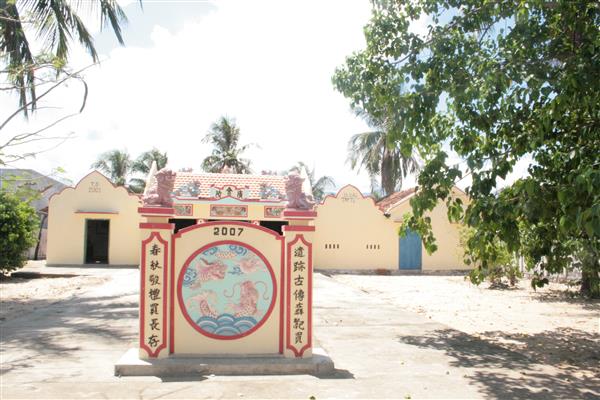Description
Quang Hoi Tomb is located in Quang Hoi II village, Van Thang commune, Van Ninh district, Khanh Hoa province.
In 1653, there was a huge migration from the central provinces into the land of Van Ninh, a part of the Vietnamese population from Quang Nam, Quang Ngai, and Binh Dinh came to the newly reclaimed land, established hamlets, and gave birth. lived and built Ong's mausoleum with bamboo and thatched roof. In the middle of the 18th century, people built the mausoleum with laterite and mixed with sand and lime; trusses, rafters made of wood; yin and yang tiled roofs; next to the sea mouth, about 5m to the west.
By 1956, the fishing community was getting bigger and bigger, so the demand for religion was higher and the contribution conditions of everyone wanted to have a more spacious Ong Tomb. At the same time, the village elders considered the previous location unsuitable, so they moved the mausoleum to a location 30m away from its previous location to the northeast. Therefore, Huynh Cu, Le Meo and Do Khong mobilized the fishermen to rebuild the mausoleum. At this time, the mausoleum was made of a wooden frame, built of bricks, roofed with tiles, and the floor and walls were made of cement mixed with sand.
Over time, Quang Hoi mausoleum was renovated in the following years:
- In 1991, to repair the main hall and money;
- In 1992, building a winter house;
- In 2001, the main hall, the East house, and the Tien sian temple were restored;
- In 2007, amending the case of ordination and ritual.
Currently, Quang Hoi Mausoleum still preserves 03 ordinations bestowed by King Khai Dinh:
- Sac Khai Dinh in the 2nd year (1917) bestowed on Southeastern Sat Hai Lang Lai General;
- Sac Khai Dinh 2nd year (1917) bestowed on Thuy Long Than Nu;
- Sac Khai Dinh in the 9th year (1924) bestowed on Thuy Long Goddess.
Quang Hoi mausoleum worships the South East Sat Hai Lang Lai General, Thuy Long Goddess, Former sage, Hau sage ...


General plan of Quang Hoi mausoleum
From the outside to the inside, Quang Hoi Mausoleum includes the following architectural works: Nghi Mon, feng shui, money sacrifice, main hall, sage house, east house. Quang Hoi Mausoleum rotates in the Southeast direction, with a total area of 852.5m2.
The festival is usually held on the 3rd day of the lunar calendar every year and lasts for 3 days. In addition to processions and sacrifices preserving the traditional cultural identity, the mausoleum also organizes folk games such as boat racing, basket shaking and boi singing...
At present, the mausoleum still preserves a very special type of folklore that is Ho Ba Trao.
During the period 1965 - 1968, the Van Thang - Van Binh Task Force was one of the main working groups of the locality. Quang Hoi Tomb is located at the mouth of the sea, located on the enemy's path of retreat, so we chose the mausoleum as a place to ambush the enemy, typically: On August 21, 1966, our troops stood guard at the mausoleum to prepare for the retreat. of the enemy to the sea, captured 02 and killed 05 enemies. Before G time on New Year's Eve, December 29 (ie, January 28, 1968) Van Ninh was divided into 3 armies: The northern wing took the Van Thang - Van Binh working armed group as the core, the southern wing took the working armed group. Van Hung - Van Luong as the core, the front wing takes the Working Armed Team Van Phu - Town as the core. According to the plan, after defeating the enemy, pull back to the town. At this time, the mausoleum was the shelter of our troops to wait for the order to pull back to the town.
Recognizing the historical - cultural values of Quang Hoi mausoleum, in 2013, Khanh Hoa Provincial People's Committee ranked it as a provincial historical - cultural relic, in Decision No. 3099/QD-CT.UBND.